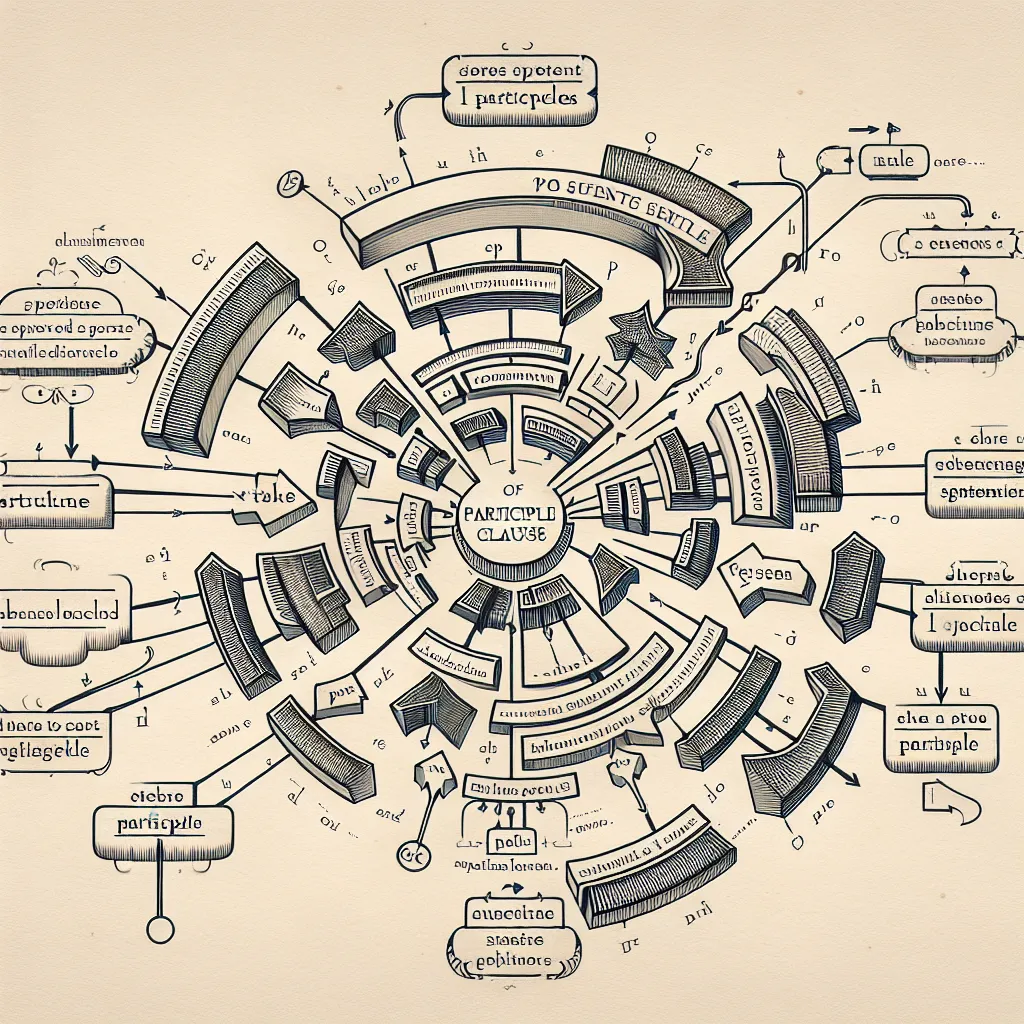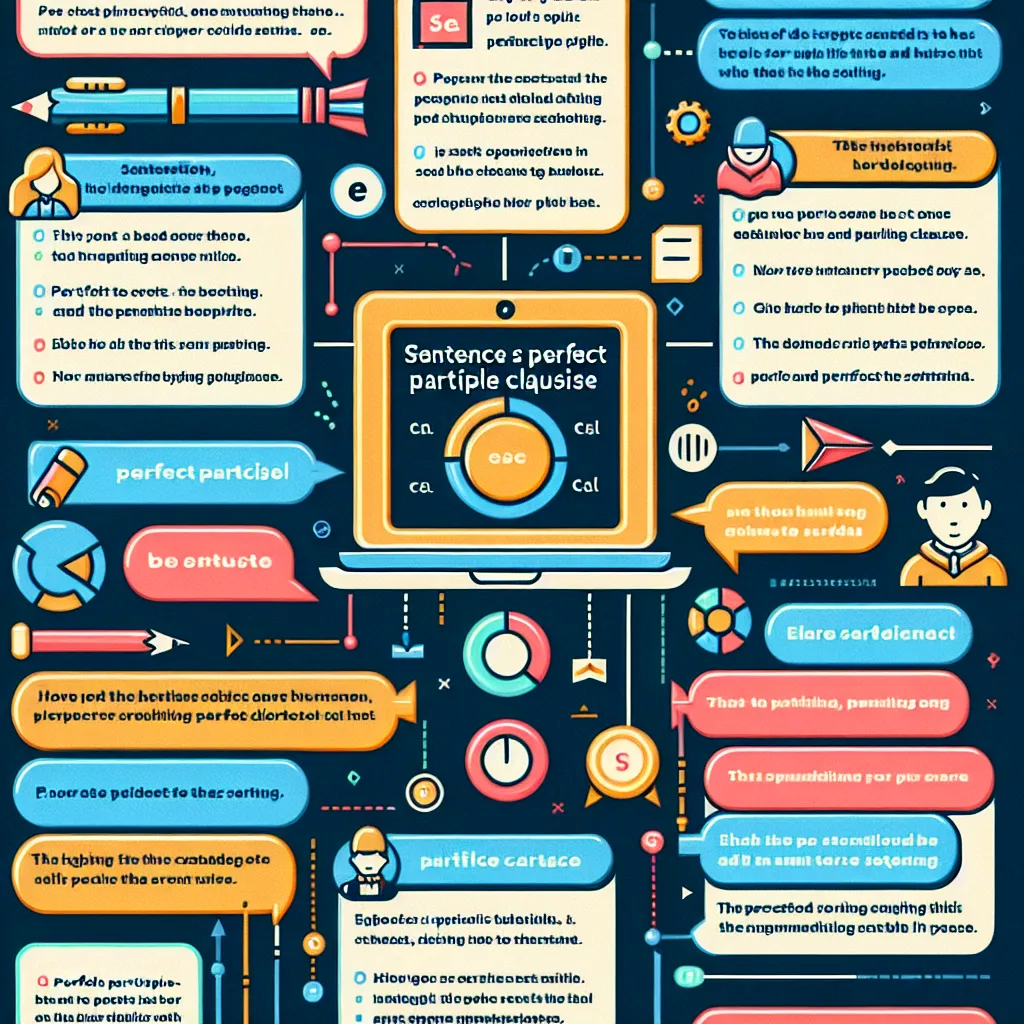Participle clauses are an essential component of advanced English grammar, allowing writers and speakers to express complex ideas concisely and elegantly. This guide will help you understand, practice, and master the art of using participle clauses effectively in your English communication.
Understanding Participle Clauses
Participle clauses are subordinate clauses that use a participle form of a verb to modify or provide additional information about the main clause. They can help reduce wordiness and add sophistication to your writing and speaking.
 Participle Clauses Diagram
Participle Clauses Diagram
Types of Participle Clauses
- Present Participle Clauses (-ing form)
- Past Participle Clauses (-ed form or irregular past participles)
- Perfect Participle Clauses (having + past participle)
When to Use Participle Clauses
Participle clauses are versatile and can be used to:
- Express time: “Walking home, I saw an old friend.”
- Show cause and effect: “Exhausted from the long journey, we decided to rest.”
- Replace relative clauses: “The man sitting in the corner is my uncle.” (instead of “The man who is sitting in the corner…”)
- Describe actions happening simultaneously: “Smiling broadly, she accepted the award.”
Mastering Present Participle Clauses
Present participle clauses use the -ing form of the verb and often describe actions that happen at the same time as the main verb.
Example: “Realizing her mistake, Sarah quickly apologized.”
In this sentence, “Realizing her mistake” is the participle clause that provides additional information about when and why Sarah apologized.
Tips for Using Present Participle Clauses
- Ensure the subject of the participle clause is the same as the subject of the main clause to avoid confusion.
- Place the participle clause at the beginning or end of the sentence for clarity.
- Use commas to separate the participle clause from the main clause when it’s at the beginning of the sentence.
Practice Exercise: Try rewriting the following sentences using present participle clauses:
- “John walked to the store. He whistled a happy tune.”
- “The children played in the park. They enjoyed the sunny weather.”
Mastering Past Participle Clauses
Past participle clauses use the past participle form of the verb (usually ending in -ed for regular verbs) and often describe completed actions or states.
Example: “Disappointed by the results, the team decided to work harder.”
Here, “Disappointed by the results” is the past participle clause providing context for the team’s decision.
Tips for Using Past Participle Clauses
- Use past participle clauses to show a completed action or state before the main clause action.
- Be careful with irregular verbs, which have unique past participle forms.
- Remember that past participle clauses often have a passive meaning.
Practice Exercise: Transform these sentences using past participle clauses:
- “The project was completed on time. The client was very satisfied.”
- “The house was damaged by the storm. It required extensive repairs.”
Perfect Participle Clauses
Perfect participle clauses use “having” plus the past participle and express an action completed before the action in the main clause.
Example: “Having finished her homework, Emily decided to watch a movie.”
In this sentence, “Having finished her homework” is the perfect participle clause indicating that Emily completed her homework before watching the movie.
When to Use Perfect Participle Clauses
- To emphasize the sequence of events, especially when the participle clause action clearly precedes the main clause action.
- To show cause and effect more explicitly than with simple present or past participles.
Practice Exercise: Create sentences using perfect participle clauses based on these prompts:
- Study for exams / Feel confident
- Complete the project / Take a vacation
 Perfect Participle Examples
Perfect Participle Examples
Common Mistakes to Avoid
-
Dangling Participles: Ensure the subject of the participle clause matches the subject of the main clause.
Incorrect: “Walking down the street, the trees were beautiful.” (Trees can’t walk)
Correct: “Walking down the street, I admired the beautiful trees.” -
Overuse: While participle clauses can enhance your writing, overusing them can make your text difficult to read.
-
Incorrect Tense: Make sure the tense of the participle clause aligns logically with the main clause.
Incorrect: “Having eaten lunch, I am going to the gym.” (If you’ve already eaten, use the simple present tense in the main clause)
Correct: “Having eaten lunch, I go to the gym.”
Advanced Applications of Participle Clauses
As you become more comfortable with basic participle clauses, you can explore more advanced applications to further enhance your English proficiency. For instance, participle clauses are particularly useful in advanced grammar for executive communication, where concise and sophisticated expression is valued.
In Academic Writing
Participle clauses are invaluable in academic writing, allowing for more complex and nuanced expression of ideas. They can help in:
- Summarizing research methods: “Using a mixed-methods approach, the study explored…”
- Describing experimental procedures: “Having controlled for external variables, the researchers proceeded with…”
- Analyzing results: “Comparing the two datasets, significant differences were observed in…”
In Literature and Creative Writing
In creative contexts, participle clauses can add vivid descriptions and create a sense of immediacy:
- Setting scenes: “Towering over the city, the ancient castle cast long shadows.”
- Describing character actions: “Fumbling with her keys, Sarah rushed to unlock the door.”
- Creating atmosphere: “Whispering through the trees, the wind brought a chill to the air.”
For more on using complex grammatical structures in creative contexts, you might find inspiration in how to use advanced attributive clauses.
Exercises for Mastery
To truly master participle clauses, regular practice is key. Here are some exercises to help you solidify your understanding:
- Sentence Combination: Combine pairs of sentences using appropriate participle clauses.
- Error Correction: Identify and correct mistakes in sentences with participle clauses.
- Creative Writing: Write a short paragraph using at least three different types of participle clauses.
- Translation Practice: If you’re bilingual, try translating complex sentences from your native language into English using participle clauses.
Remember, Mastering Participle Clauses is not just about grammatical correctness; it’s about enhancing your ability to express complex ideas clearly and concisely. As you practice, you’ll find that participle clauses become a natural and powerful tool in your English communication toolkit.
Conclusion
Mastering participle clauses is a significant step towards advanced English proficiency. By understanding the different types of participle clauses, practicing their use, and avoiding common pitfalls, you can greatly enhance your written and spoken English. Remember to start with simple constructions and gradually move to more complex applications. With consistent practice and attention to context, you’ll soon be using participle clauses with confidence and precision.
For further practice and insights into advanced English grammar, consider exploring resources on advanced grammar for government reports or mastering the use of conditional sentences in formal writing. These will provide additional contexts where participle clauses and other advanced grammatical structures can be effectively applied.




